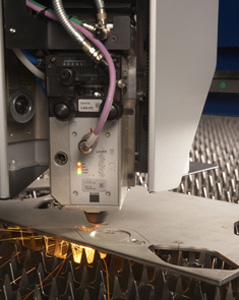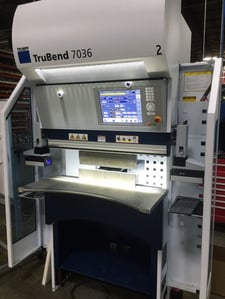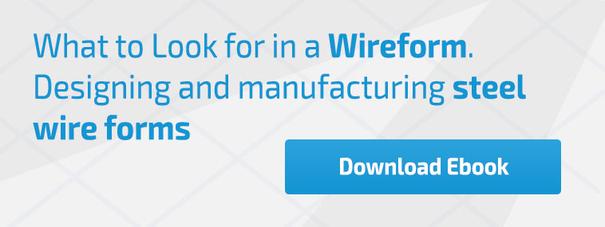 There are many metal forming tools that the team at Marlin Steel uses to create custom sheet metal forms. Two of the most frequently-used types of metal forming machines on the Marlin production floor are laser cutting machines and metal stamping and press machines.
There are many metal forming tools that the team at Marlin Steel uses to create custom sheet metal forms. Two of the most frequently-used types of metal forming machines on the Marlin production floor are laser cutting machines and metal stamping and press machines.
Every day, Marlin’s employees use one machine or the other to create custom metal forms for clients the world over. However, many of our clients ask us: “Which is better, laser cutting or metal stamping?” The answer depends on what the client needs.
To help you assess whether you should use laser-cut parts or ones shaped using metal stamping, here’s a quick laser cutting vs metal stamping comparison. In this comparison, you’ll find some of the pros and cons of each process.
The Advantages of Laser Cutting
Laser cutting machines are incredibly powerful tools for quickly cutting holes into sheet metal plates. Some of the key advantages of laser cutting machines are:
- Stress-Free Cutting. Unlike a stamping machine or press brake, a laser cutting machine does not rely on mechanical force to penetrate metal. This eliminates many of the microscopic fractures and stress marks that might weaken a piece of sheet metal that was bent mechanically.
- Extremely Close Cutting. When making custom metal shapes from sheet metal cutouts, the fact that laser cutting is stress-free allows for metal shapes to be cut extremely close together. This allows for extreme material efficiency when creating metal cutouts—allowing more metal shapes to be created from a single metal sheet.
- Smooth Edges for Cuts. Another benefit of using lasers to cut sheet metal forms is that the laser leaves behind a smooth, shiny surface. This helps to reduce the risk of sharps or burrs being left behind on a laser-cut object.
- Reduced Tooling Wear. Because a laser cutting machine doesn’t need to make physical contact with the workpiece, there is far less wear and tear on the laser cutter than there would be on a bending machine or press brake. This helps to extend the useful life of the laser cutting machine while reducing maintenance costs (though the laser diode will still need to be serviced or replaced eventually).
- Less Need for Secondary Operations. Because the laser cutter leaves a smooth cutting edge, there’s less need for secondary operations to remove sharps and burrs. This helps to increase overall manufacturing speed so more parts can be manufactured in a day.
What Disadvantages Does Laser Cutting Have?
So, what are some of the disadvantages of laser cutting? Some of the key things to keep in mind with laser cutting are:
- Laser Cutting May Alter Steel Properties. Some types of steel alloys may change their chemical properties after being exposed to extreme temperatures—such the temperatures involved in the laser cutting process. This can impact the performance of the workpiece after the fact. So, laser cutting isn’t always recommended for use on metal alloys that experience such changes.
- Laser Cutting Machines Have Cutting Depth Limitations. There is an upper limit to how thick a piece of metal can be before the laser cutter will not be able to make a clean cut. This may vary from one workpiece to another depending on the type of metal it’s made out of. If the metal is too thick for the laser cutter, there may be some spalling and distortion in the cut.
- Laser Cutting Machines Cannot Make Bends. Some sheet metal forms require the metal to be both cut and bent. Lasers, unfortunately, cannot bend metal forms. For this task, a metal stamping or bending machine is required.
Advantages of Metal Stamping Machines and Press Brakes
 Metal stamping machines and press brakes are incredibly useful for custom metal forming. But, what makes these machines preferable to laser cutting machines? Here are a few of the advantages of using metal stamping and press brake machines:
Metal stamping machines and press brakes are incredibly useful for custom metal forming. But, what makes these machines preferable to laser cutting machines? Here are a few of the advantages of using metal stamping and press brake machines:
- More Than Just Cutting. The biggest advantage of metal stamping and press brake machinery is that these machines can do more than just cut holes in metal. A metal stamping machine, for example, can flatten, swage, or coin metal into a specific shape to meet a need. Meanwhile, press brakes can bend sheet metal or steel wire forms at specific angles to create complicated shapes for specific applications.
- Shaping Thicker Metal Plates. Press brakes and metal stamping machines are limited primarily by the amount of force they can apply to a workpiece and the condition of the die. This allows high-tonnage presses to shape and cut metal forms that are thicker than what some laser cutting machines can manage.
- Shaping a Wider Variety of Metal Alloys. High temperature-resistant metal alloys can be difficult to cut with a laser because their melting point is so high. Press brakes and metal stamping machines can shape and cut these metals more easily than laser cutters. This makes press brakes and stamping machines preferable for some metal forming applications.
What Are the Disadvantages of Metal Stamping and Bending?
What are some of the disadvantages of using mechanical force for metal forming? Two of the cons of using metal stamping machines are:
- High Tooling Maintenance. To keep metal stamping and press brake machines working in top condition, they require frequent maintenance. Tools and dies can wear out quickly, especially when being constantly used to shape hard metal alloys such as annealed and stress-relieved grade 430 stainless steel. This means more time and money spent on mechanical maintenance.
- Some Bends Create Structural Weaknesses. If not handled correctly, a metal bend or cut can create structural weaknesses. For example, if a bend is too deep for the metal’s internal radii limitations, or if there is some improper motion during a cut, it could make the metal brittle and easy to break.
So, which process is better for your manufacturing process? That’s an answer that depends on the application and materials involved. If you need help creating the perfect custom metal form for your needs, contact the Marlin Steel team today!



.gif)


